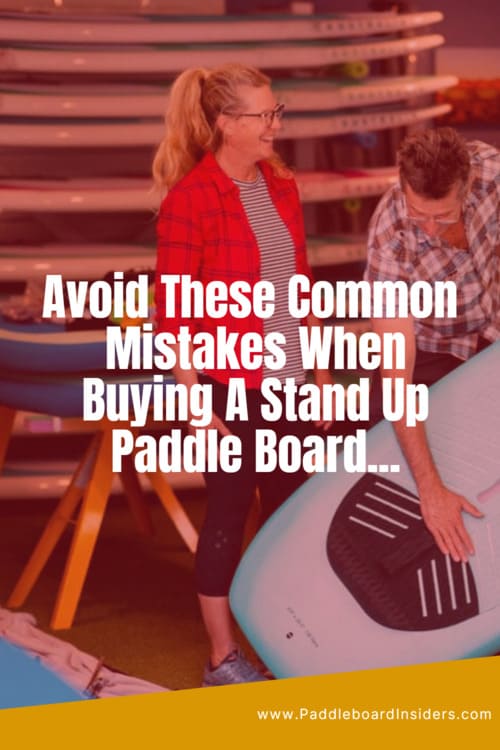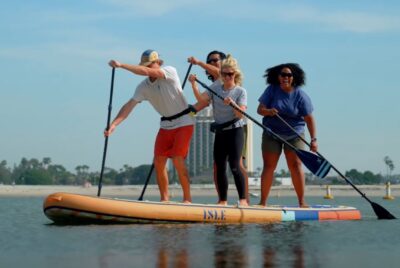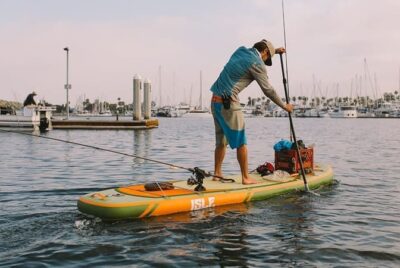Don’t Make These Common Mistakes When Buying A Stand Up Paddle Board…
*We may earn a commission for purchases made using our links. Please see our disclosure to learn more.
Shopping for a stand up paddle board can be as tricky as balancing on one. Every year, plenty of buyers regret not choosing the right SUP for their adventures. This article will guide you through common pitfalls and help you pick the perfect board with confidence.
Get ready to paddle smarter!
| Looking for our best paddle board product recommendations? Check the Paddleboard Insiders Buyer Guides |
Table Of Contents
The Importance of Choosing the Right Stand Up Paddle Board
Selecting the ideal stand up paddle board is crucial for your enjoyment and safety on the water. Every paddle board has a specific volume and weight capacity that influences its stability and performance.
If you choose a board that’s too small for your body type, you might find yourself struggling to balance, which can lead to frustration or even unexpected swims. On the flip side, a board that’s too large can be cumbersome and difficult to maneuver, making it tough to navigate through waves or around tight spaces.
Paddle boards come in various shapes and sizes suited for different activities – racing, yoga, fishing, or simply cruising along calm waters. The right choice will enhance your paddling technique while providing ample support underfoot.
Consider factors like fin options and paddle blade shapes; they play significant roles in how the board tracks through water and how much effort you need to put into each stroke. Opting for an inflatable paddle board might suit those looking for easy storage and transportation options without sacrificing on-water performance.
It’s all about finding a balance between what fits your lifestyle best while ensuring maximum fun out on the lake or sea.
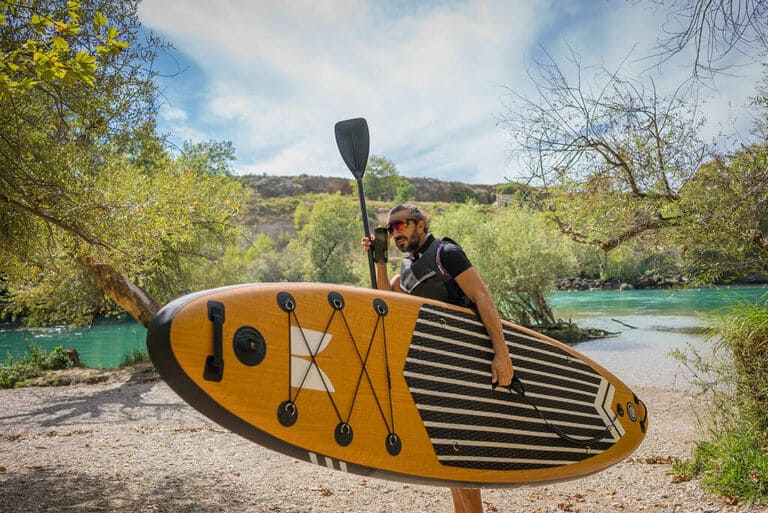
Common Mistakes to Avoid When Buying a SUP
Not considering your needs and preferences, neglecting to properly research and test the board, and underestimating the cost are all common mistakes to avoid when purchasing a stand-up paddleboard.
Make sure you’re aware of these potential pitfalls before making your purchase.
Not considering your needs and preferences
Choosing a stand up paddle board that doesn’t align with your personal needs and preferences can lead to disappointment and may even keep you off the water altogether. Every paddler has unique requirements based on their skill level, body type, and what they want to achieve on the water.
If you’re a beginner, opting for a stable, wider board will help you gain confidence as you learn. On the other hand, if speed is your goal, look for something sleeker with a pointed nose.
Consider how often you’ll be using your new stand up paddle board and where. Will it be mostly calm lake waters or are ocean waves calling your name? Your activity choice matters too; yoga enthusiasts might prefer boards with full deck pads while adventurers might need bungee straps for securing gear.
Tailor your decision to these factors to get the most satisfaction from your stand up paddle boarding experience without compromising on fun or functionality.
Ignoring the different types of paddle boards
After pinpointing your individual needs, it’s equally crucial to pay attention to the various paddle boards on the market. Each type is crafted for different activities and skill levels.
Racing boards are slender and fast, ideal for those looking to slice through water with speed. Touring boards have a pointed nose designed to glide long distances. All-around boards boast versatility, perfect for beginners or paddlers who enjoy a mix of activities.
Specialized boards like yoga SUPs feature wider decks for stability as you strike a pose on the water, while fishing SUPs come equipped with extra mounts for gear. Opting for an inflatable paddle board means easier transportation and storage but don’t short-change the experience by ignoring solid options that may offer better performance in certain conditions.
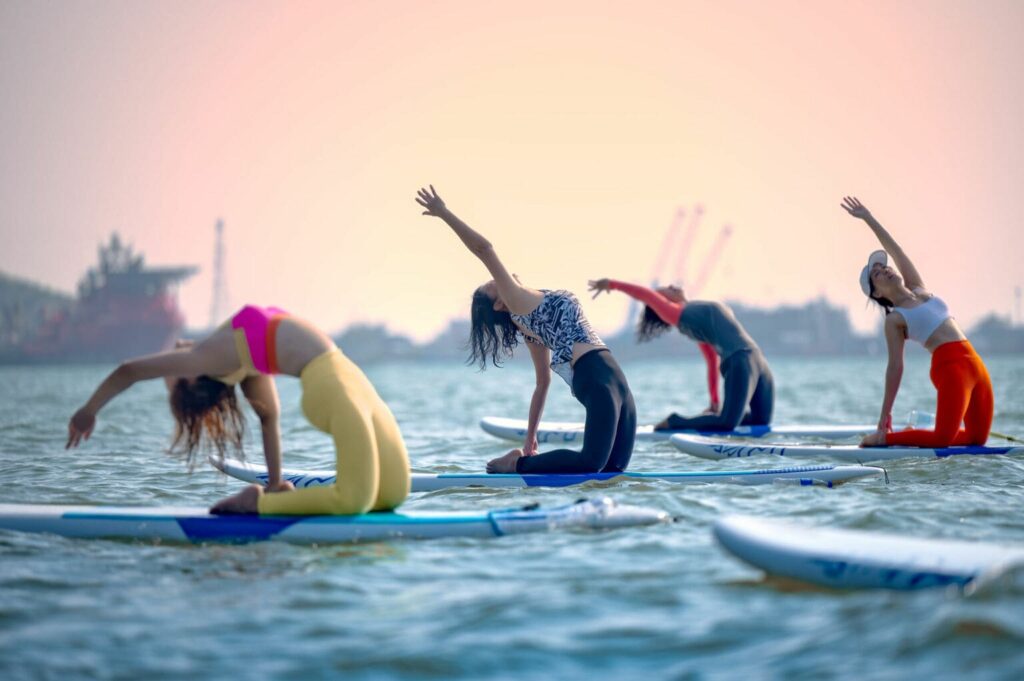
The right decision hinges on understanding how each model aligns with your intended use – from leisurely lake excursions to ocean surfing challenges.
Neglecting to properly research and test the board
Neglecting proper research and testing of the stand-up paddle board can lead to a mismatch between your needs and what the board offers. This oversight may result in choosing a board that doesn’t suit your intended use or skill level, such as selecting a high-performance board when you’re just starting out.
Failing to thoroughly test different boards can lead to disappointment once you hit the water. Without adequate testing, you may find that the board’s stability, maneuverability, or weight capacity are not conducive to an enjoyable paddle boarding experience.
Therefore, taking the time for thorough research and testing can ensure that you make an informed decision about which stand-up paddle board fits your requirements best.
Not factoring in storage and transportation options
When purchasing a stand-up paddle board, take into account the storage and transportation options. Consider where you will store your board at home or in transit, as well as how you plan to transport it to and from the water.
Failure to do so may result in difficulties finding suitable storage space or challenges in transporting the board to your desired paddling location.
Ensure that you factor in storage and transportation options when choosing a stand-up paddleboard. This will prevent potential issues related to storing and moving your board, making for a smoother experience overall.
Underestimating the cost
Considering the cost of purchasing a stand-up paddle board is crucial. Underestimating the financial investment involved can lead to disappointment and dissatisfaction. It’s important to remember that quality paddle boards may come at a higher price, but they offer greater durability and enhanced performance, making them a smarter long-term investment.
Many new buyers overlook additional costs such as paddles, leashes, and safety gear when budgeting for their SUP purchase. Being mindful of these expenses will help you make an informed decision about your total expenditure.

Tips for Choosing the Perfect SUP
Consider your intended use, compare different paddle board styles, evaluate the hull type, decide between a solid or inflatable board, pay attention to volume, weight capacity, length, width, and fin options.
Budget accordingly and think about storage and transportation.
Consider your intended use
When considering your intended use, think about where you will be paddle boarding – whether on calm lakes, choppy coastal waters, or crashing waves. Your intended location will determine the type of stand-up paddle board that best suits your needs.
Additionally, think about how often and for what purpose you will be using the board; this will help you decide between a solid or inflatable board and consider factors like stability, speed, maneuverability, and storage.
Weight capacity is another critical element to evaluate when determining your intended use for the stand-up paddle board. If carrying gear or taking along a pet is part of your plans, choose a board with a higher weight capacity to accommodate these additional items without compromising performance or safety.
Compare different paddle board styles
When choosing a stand-up paddle board (SUP), it’s vital to compare the various styles available. Here are some key differences between paddle board styles to consider:
- All-around: Versatile for different water conditions
- Touring: Designed for long-distance paddling with enhanced speed and stability
- Surf-specific: Tailored for wave riding with maneuverability and responsiveness
- Racing: Streamlined for speed and performance in competitions
- Yoga/fitness: Stable and wide boards suitable for yoga or workout activities on water
Here is a visual explainer of the most common types of paddle boards:
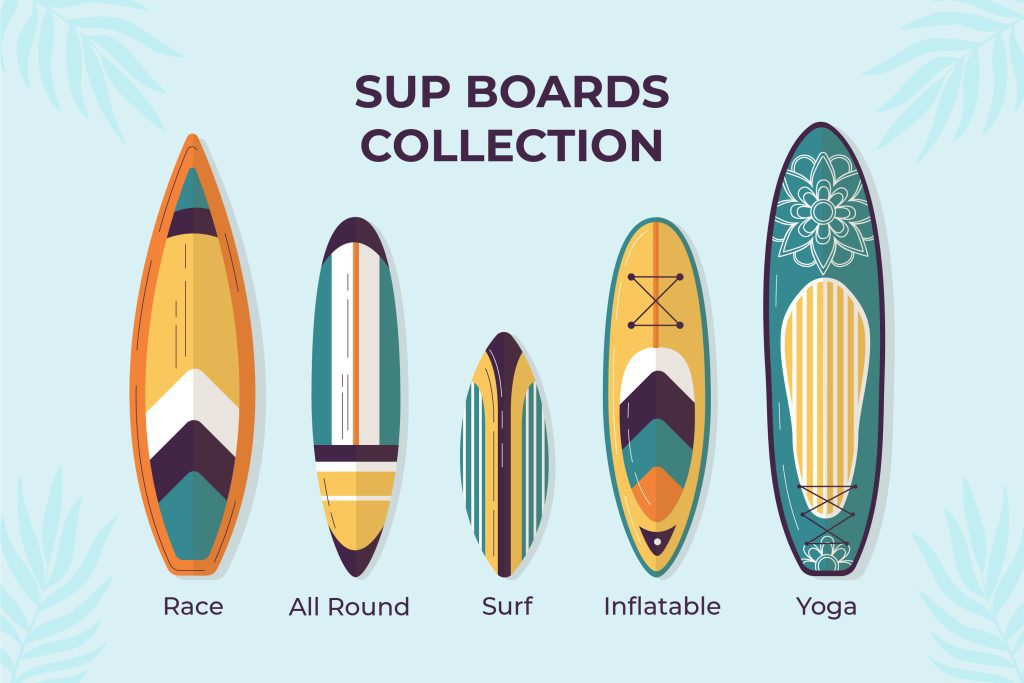
Evaluate the hull type
After considering different paddle board styles, it’s crucial to evaluate the hull type when choosing a stand-up paddleboard (SUP). The hull type determines how the board performs in various water conditions.
A planing hull is ideal for stability and maneuverability, making it suitable for beginners and casual paddling in calm waters. On the other hand, a displacement hull suits long-distance touring and offers better speed through choppy or rough waters.
When selecting a SUP with a displacement hull, bear in mind that it may be less stable than one with a planing hull. Understanding the distinctions between these two hull types ensures you choose an SUP tailored to your specific needs and preferences.
Decide between a solid or inflatable board
Consider whether you need a solid or inflatable board based on your storage and transportation needs, as well as your intended use of the paddle board. Evaluate the trade-offs in terms of performance, convenience, and durability before making your decision.
Weigh factors such as ease of transport, storage space requirements, and how you plan to use the board when choosing between a solid or inflatable SUP.
When comparing solid boards with inflatables, consider their respective advantages and disadvantages to make an informed decision that aligns with your preferences and practical considerations.
| Here’s what you need to know about this debate: Comparing Inflatable Vs Solid Paddle Boards: Which Is Better For Paddlers? |
Pay attention to volume, weight capacity, length, width, and fin options
Consider the weight capacity, as this will determine how much gear and weight the paddle board can support. Look at the dimensions of length and width to find a board that offers stability for your skill level.
Evaluate fin options to enhance maneuverability in various water conditions. Take into account volume for sufficient buoyancy based on your weight and intended use.
Understanding these details is crucial for finding a stand-up paddleboard that matches your needs. When choosing the right board, paying attention to volume, weight capacity, length, width, and fin options ensures an enjoyable experience on the water without limitations.
| Here is an simple process that you can use to choose a paddle board: A Complete Beginners Guide To Choosing An Inflatable Paddleboard |
Budget accordingly
Plan your budget thoughtfully, ensuring you account for the cost of the stand-up paddle board, paddle, leash, and any additional accessories like a carrying bag or roof rack. Take into consideration any potential maintenance costs to keep your board in top condition.
Factor in expenses for safety gear such as a life jacket or personal flotation device to enjoy worry-free paddling.
Finally, be sure to allocate funds for any training or lessons if you’re new to paddle boarding. It’s essential to have some flexibility in your budget for unexpected expenses that may arise when getting started with this fun water sport.
| Here are some amazing paddle boards for people on a budget: 8 Of The Best Inflatable Stand Up Paddleboards For People On A Budget |
Think about storage and transportation
Consider the dimensions of your stand-up paddle board to ensure it fits in your vehicle or storage space. Evaluate whether you can easily transport the board to and from your intended paddling locations.
Look into options for carrying and securing the board, such as roof racks or inflatable boards that can be deflated and packed into a compact bag for convenience.
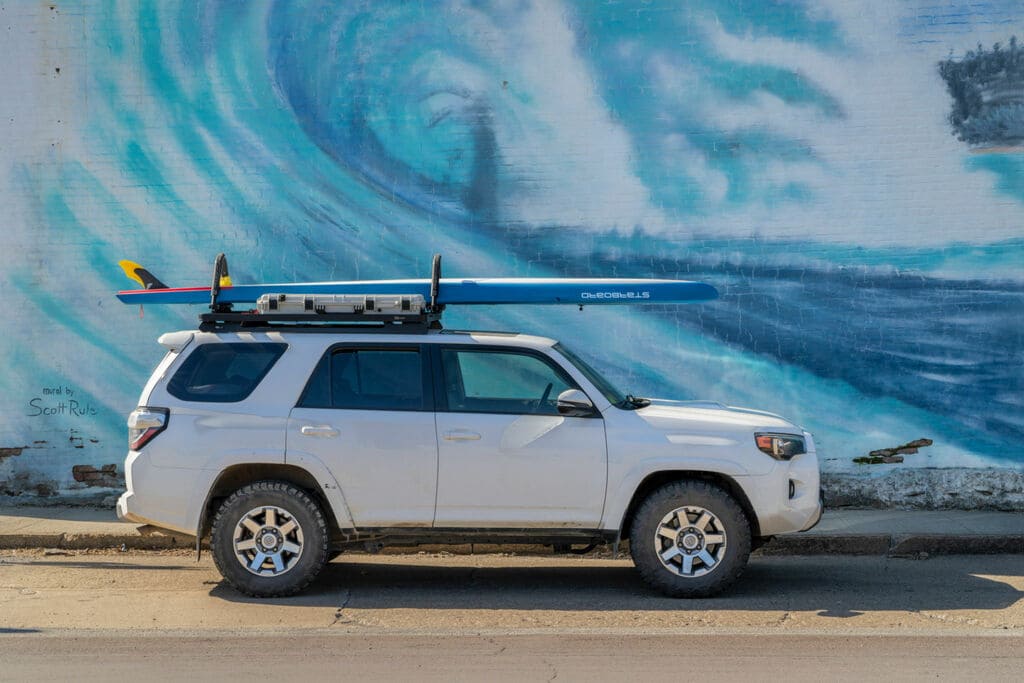
When considering storage and transportation, it’s essential to plan how you will move and store your new stand up paddle board securely to protect your investment.
| Here’s what you need to know about storing and transporting a SUP: The 8 Best Paddle Board Racks For Easy Transport & Storage (2024 Edition) |
Three Amazing Stand Up Paddle Board Recommendations
So let’s close this article off with a a few recommendations of great paddle boards that I’m loving at the moment. These are designed to take all the relevant considerations above into account and in my opinion these are some of the best SUPs on the market right now.
Recommendation 1: ISLE Pioneer 10’6″

Where To Buy: Amazon
Key Features:
– Allows up to 285lbs in weight
– 10’6″ in size
– Comes with bag, leash, fin and paddle
Best for everyday use.
The ISLE Pioneer, the flagship model from ISLE, is highly regarded and their best-selling product. This paddleboard is designed with versatility in mind, making it a great choice for a wide range of users. It features a robust construction using a double-layer technique and incorporates advanced drop-stitch technology, ensuring remarkable durability and a long lifespan. The design of this inflatable paddleboard focuses on stability while maintaining a lightweight structure, accommodating individuals weighing up to 285 lbs comfortably.
For those starting out in paddleboarding, the ISLE Pioneer stands out as a strong option for your next stand-up paddleboarding (SUP) adventure.
Take a look at the standout features of this paddle board
| Check Price ➡️ Amazon |
Recommendation 2: Tower Adventurer 2
Where To Buy: Tower Paddleboards
Specs & Features:
– Dimensions of 10’4″ x 32″ x 6′
– Weight capacity of 350 lbs
– Comes with paddle, board, pump, fin and book
Best for beginner paddlers.
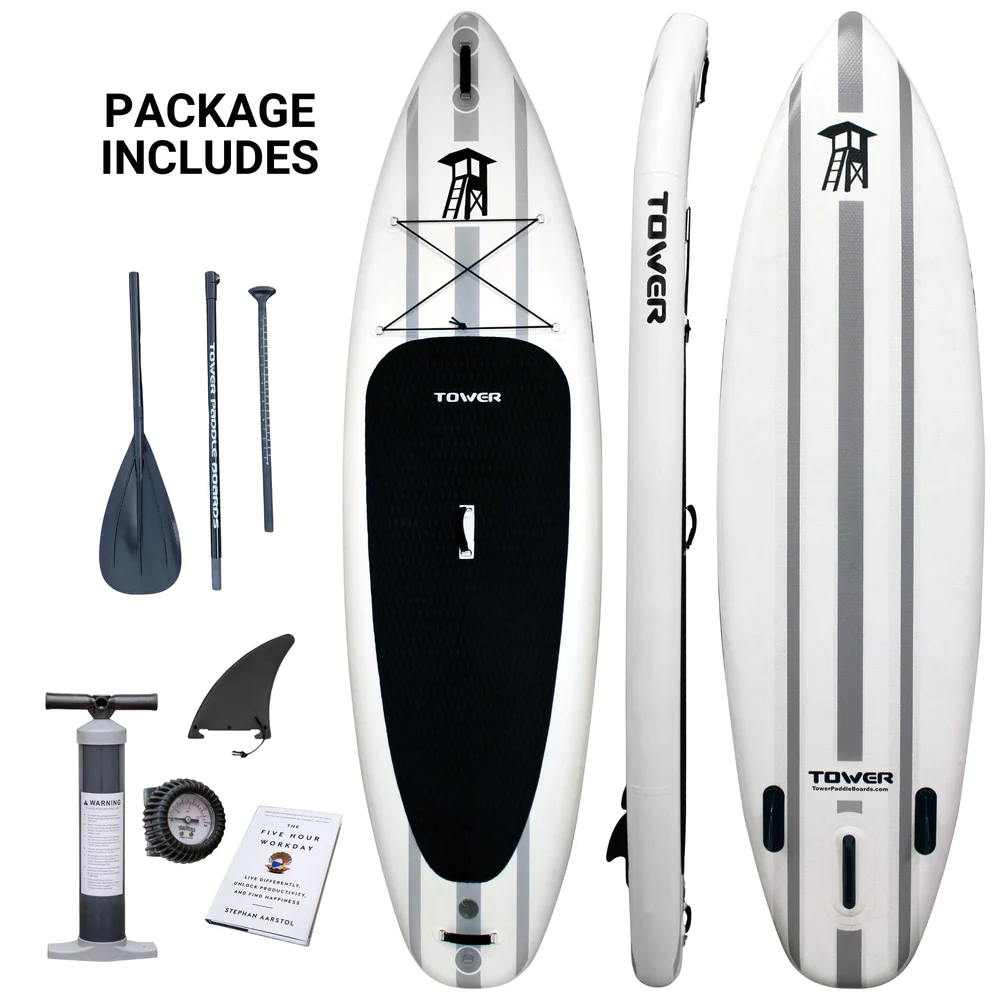
The Tower Adventurer 2 inflatable paddle board is highly recommended for paddlers of all levels, particularly those just starting out. It’s widely recognized for its excellent stability and support, providing new paddlers with the confidence they need on the water. Coming from the well-respected Tower brand, known for its quality in the paddle board industry, this board offers assured reliability. It’s easy to balance on and exceptionally durable, making it a great choice for the majority of users.
This board excels in recreational paddling, offering a fine balance between stability and maneuverability. It’s an ideal option for family activities or for individuals who are new to paddleboarding. For those in search of a reliable and enjoyable experience in paddleboarding, the Tower Adventurer 2 stands out as a premier choice.
| Check Price ➡️ Tower Paddleboards |
Recommendation 3: Atoll 11′ iSUP
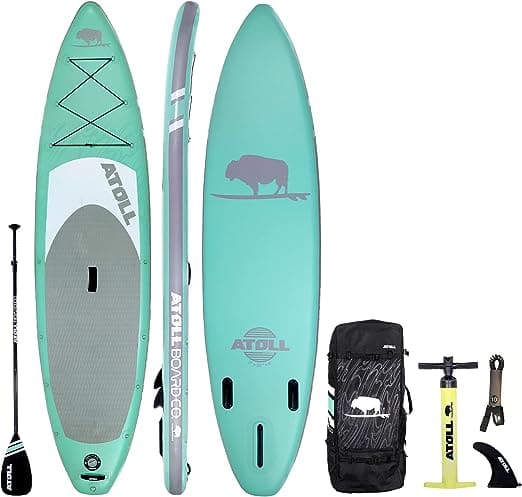
Where To Buy: Amazon
Specs & Features:
– Dimensions of 11′ x 32″ x 25″
– Weight capacity of 400 lbs
– Comes with board, bag, leash, fin and paddle
Best for heavier riders
The Atoll Inflatable Stand Up Paddle Board (ISUP) stands out as an excellent option for heavier paddlers. The 2024 model boasts an advanced, ultra-light dual-layer PVC structure, which is 40% lighter than competing models while maintaining impressive strength. This 11-foot paddleboard comes equipped with a high-pressure Bravo dual-action hand pump for easy inflation.
Measuring 25 inches in thickness, 32 inches in width, and 11 feet in length, this board is a great all-purpose choice. It’s reinforced with a second layer of PVC for added firmness and features 15 D-rings for increased versatility. The board’s fixed Tri-fin design enhances tracking and stability. Additionally, it comes with a 2-year manufacturer’s warranty, offering additional assurance. This paddleboard is an ideal pick for those new to paddleboarding or looking to upgrade their existing equipment.
| Check Price ➡️ Amazon |
Conclusion
To avoid common mistakes when buying a stand up paddle board, it’s crucial to assess your needs and preferences. Ensure that you thoroughly research and test the board before making a purchase.
Always factor in storage and transportation options along with budget considerations. By evaluating these factors, you can make an informed decision and find the perfect stand-up paddle board for your needs.
| Looking for insider guides to some amazing paddle boarding locations? Check the Paddleboard Insiders Location Guides |
FAQs
What should I look for when buying a stand-up paddle board?
Consider the board’s size, stability, weight capacity, and construction material to suit your paddling needs and skill level.
Can I use any paddle with a stand-up paddle board?
It is important to use a paddle specifically designed for stand-up paddling to ensure efficiency and comfort during use.
How do I know if a stand up paddle board is the right size for me?
The right size of the board depends on your weight and skill level; it’s generally recommended to choose a longer and wider board for beginners or heavier riders.
Should I buy an inflatable or solid stand-up paddle board?
Your choice between inflatable or solid boards depends on factors like storage space, transport convenience, and intended use in different water conditions.
What are common mistakes when purchasing a stand-up paddle board?
Avoid common mistakes such as overlooking the importance of proper sizing, opting for low-quality accessories, ignoring essential features, or overspending beyond your budget.
